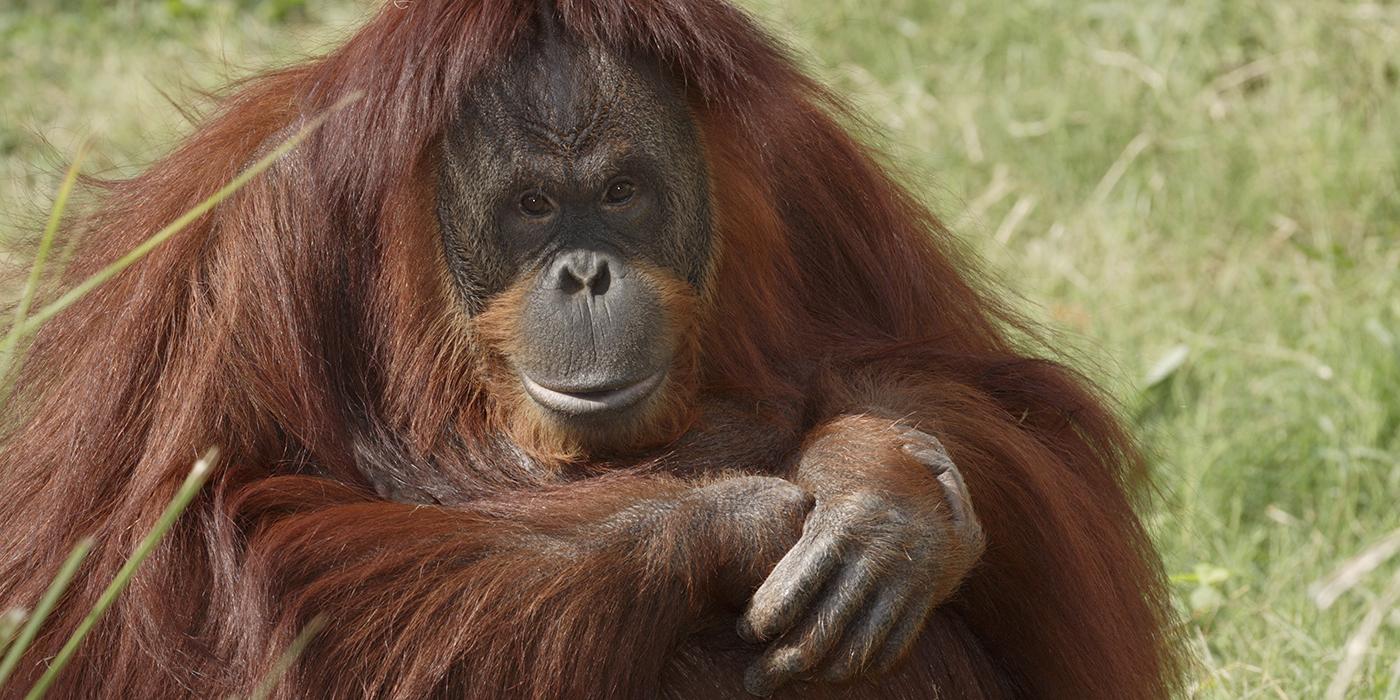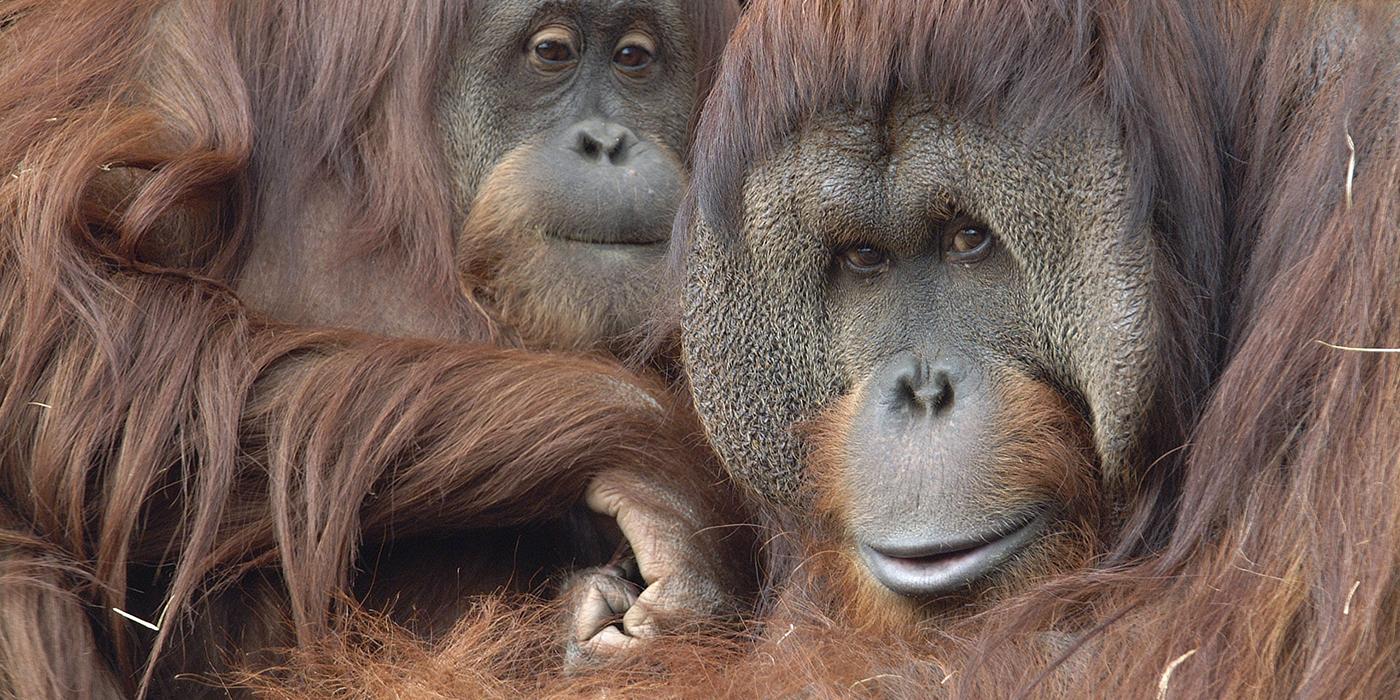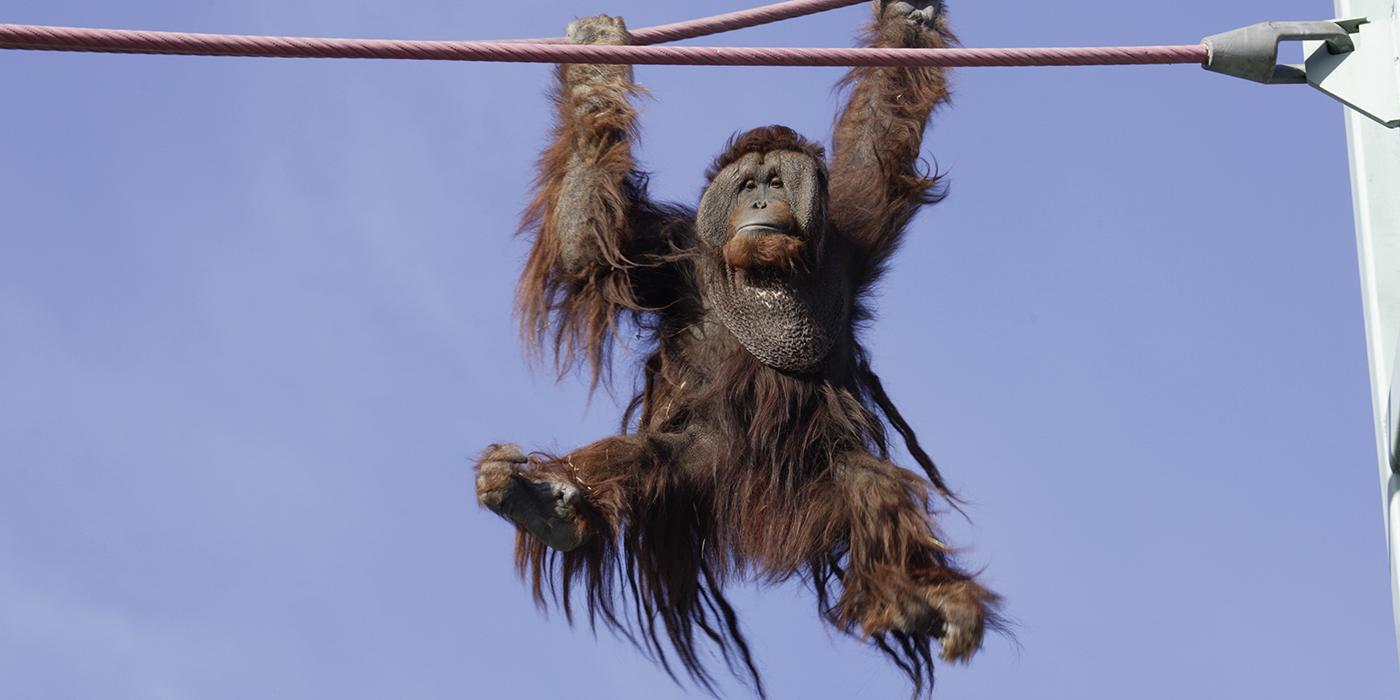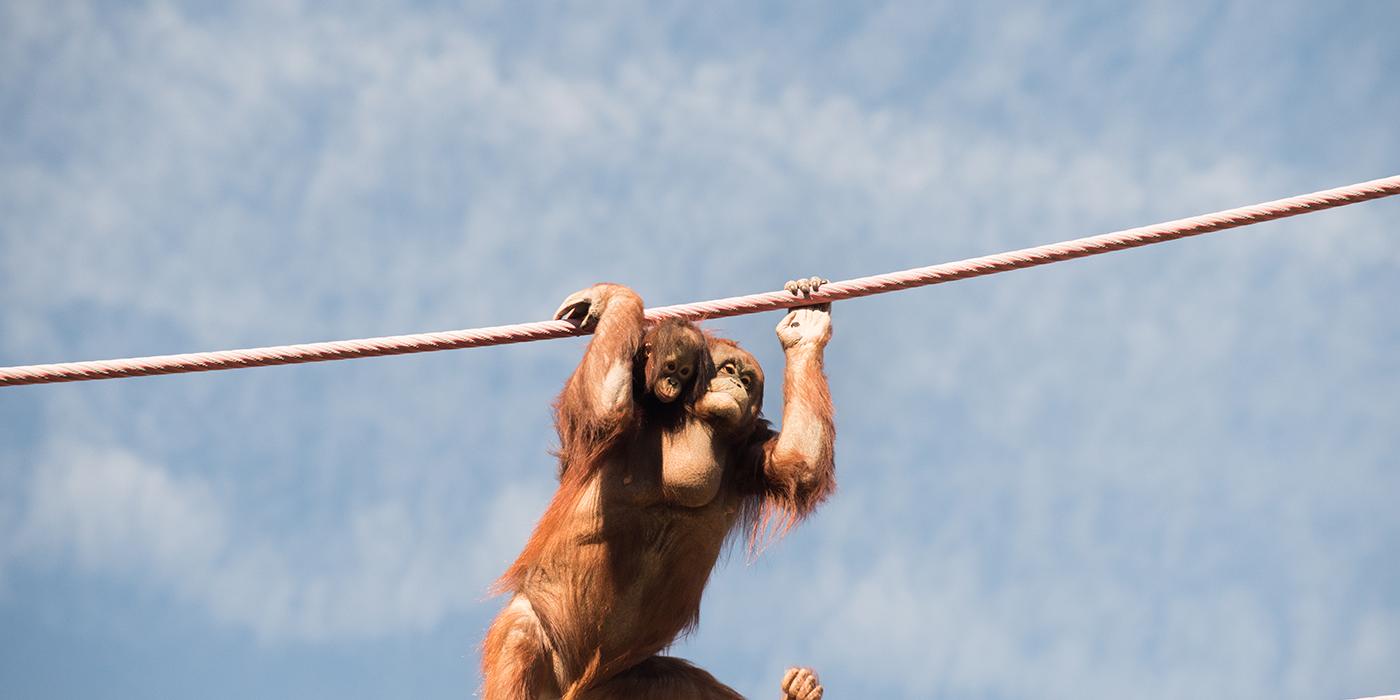Physical Description
Orangutans have long, sparse orange or reddish hair unequally distributed over their bodies. They have large jaws and flattened noses in concave faces.
Orangutans are the largest arboreal mammals and are very well adapted to life in the trees, with arms much longer than their legs. They have grasping hands and feet with long curved fingers and toes. They have distinctive fingerprints and no visible external tails.
You can typically tell male and female orangutans apart by looking at them. Males and females have flabby throat sacs, which become very large in adult males. Adult males have deep chests and much longer body hair than females do. Males also typically develop large cheek pads, which demonstrate genetic fitness and amplify their long calls.
Orangutans can brachiate—swing hand over hand—but they normally move cautiously through large trees by climbing and walking. This allows them to distribute their weight among the branches. Orangutans' hands make them graceful and swift while swinging, but it makes walking on the ground very slow and awkward.
Orangutans sometimes travel on the ground when going long distances because appropriate sized branches may not always be available. When on the ground, they use all four limbs, supporting themselves on the sides of clenched fists, or occasionally walk on upright on two legs. Orangutans also come down if there is a need to find food and water elsewhere, for example, if there is a drought or fire.
It can be difficult to tell Sumatran and Bornean orangutans apart. Generally, Sumatran orangutans are lighter in color, have longer body hair and less pendulous throat sacs than Bornean orangutans, but the only reliable way to tell the difference between Sumatran and Bornean orangutans is by looking at their chromosomes.
Size
Wild adult females weigh between 80 and 120 pounds (36 and 54 kilograms), while wild adult males weigh 170 and 220 pounds (77 and 100 kilograms). Animals in zoos tend to be 50 to 100 pounds (23 to 45 kilograms) heavier due to a consistent supply of high quality food.
Native Habitat
Orangutans live on the Indonesian island of Sumatra and in both the Malaysian and Indonesian portions of the island of Borneo. They are highly arboreal and live in all levels of the forest, from floor to canopy. Habitats range from peat swamp forests near sea level to mountainous forests almost a mile (1.6 kilometers) above sea level. As humans have moved into the lower elevations—the orangutan's original habitat—orangutans have moved up the mountainsides.
Lifespan
The median life expectancy for male Bornean orangutans is about 27 years and for male Sumatran orangutans is about 25 years. The median life expectancy for female Sumatran orangutans is about 32 years. There is not enough available data on the life expectancy of female Bornean orangutans.
Communication
Orangutans are more solitary than other great apes and do not have as complicated a vocal repertoire as some of the more gregarious primates. Orangutans rely more on facial expressions and body language to communicate. Among the vocalizations they use are kiss-squeak and belching vocalizations when they are upset, and a loud, deep long call used typically by males for long-distance communication.
This long call resonates in the male's enlarged throat sac and echoes through the forest. It is used to locate and advertise the male's presence to females or warn other males away. It can be heard a kilometer or more away (more than half a mile). Certain vocalizations such as nest smacks and throat scrapes are considered cultural and are found in some populations of wild orangutans but not in others.
Food/Eating Habits
Orangutans eat primarily fruit and play an important role dispersing seeds through defecation. Although they spend a majority of their total foraging time feeding on fruits whenever they are available, orangutans also eat insects and flowers, and during times of fruit scarcity, fall back on a variety of other types of food, including inner bark, leaves, and other vegetation. Orangutans have also been observed eating mineral-rich soil, bird eggs and, occasionally, small mammals such as rats and slow lorises. Orangutans get water from a variety of sources, including tree holes and leaves that fill with water during the rainy season.
When water is difficult to reach, orangutans chew leaves to make a pulpy sponge to soak up the water. Orangutans in some wild populations modify small sticks, which they hold in their lips while probing in tree trunks for food such as honey. Orangutans exhibit a variety of geographically variable innovative behaviors, some of which are considered cultural. Among these behaviors are certain forms of tool-use, including the modification of sticks by a population of Sumatran orangutans to open Neesia fruits and more efficiently harvest their seeds.
Orangutans have a long period of infant dependency (weaning around age six or seven) with exceptionally long inter-birth intervals (at least eight years in Sumatran orangutans and a little bit shorter in Bornean orangutans). This may be at least partially due to diet. Mothers teach their infants what food to eat, where to find that food, in which trees and during which seasons. Young orangutans must learn about hundreds of varieties of fruit, where to find them seasonally and how to open them.
In the morning, the orangutans at the Zoo are often fed together. Food items are cut up and spread over a wide area. In the afternoon, individuals are separated so each animal gets its share of preferred food items. In the morning, the animals are given greens, green beans, carrots, broccoli and primate chow. In the evening, they are given bananas, apples, primate chow, greens and a selection of other fruits and vegetables. Forage items placed in hay for the orangutans include air-popped popcorn, diced fruits and veggies, beans and sunflower seeds. Browse (fresh tree trimmings) is given daily.
Sleep Habits
Orangutans typically build sleeping nests above the ground in various positions of one or more trees. They usually build and sleep in a fresh nest each night, but they will sometimes re-enter or rebuild an older nest. They will also sometimes nap in a less carefully constructed day nest.
Social Structure
Orangutans live semi-solitary lives in the wild. While they are the most solitary of the great apes, it should be noted that orangutans are highly social and exhibit social tolerance during times of high fruit abundance when they come together in aggregations known as parties.
Adult females travel through the forest with their dependent offspring. Females do not live in tight social groups, but they are familiar with and have relationships with other females in the area. Adult males have large home ranges that overlap those of multiple females. Males typically range alone except when they mate with females, forming consortships that last up to several weeks. Males may also join other orangutans of various sexes and ages in feeding aggregations. Individuals within a certain range appear to know others and interact comfortably when they encounter each other.
Flanged males (males with flanges, also known as cheek pads) use long calls to attract females and to discourage the approach of other males. Throat sacs add resonance to long calls, which are specific to individual males. Orangutans of all ages and sexes give kiss squeak vocalizations, engage in branch-shaking displays and sometimes even uproot dead trees when confronted by unknown individuals or when they are not habituated to the presence of human observers. In zoos, displays consist of throwing around tubs and other objects.
Orangutans' social structure is connected to the distribution of food resources, primarily fruit. Orangutans spread out to get enough to eat throughout the year. Because they exhibit high social tolerance, orangutans are quite adaptable to living together when food is plentiful and when there is adequate housing space, such as at the Smithsonian's National Zoo. Animals will segregate themselves as needed, and as males mature, they may become more territorial and often must be housed separately.
Reproduction and Development
Orangutans usually have a single baby, and twins are rare. Gestation is seven-and-a-half to eight-and-a-half months. From birth, orangutan infants cling to their mothers as they maneuver through the trees. The orangutan has the longest period of dependence on the mother of any other land-dwelling animal, including humans. Infant orangutans can nurse until they are six to seven years old. However, weaning is highly variable, depending on the mother. It is thought that weaning occurs sooner if food is abundant and the infant can switch to solids.
A female will only have a baby about every seven to nine years, resulting in only four to five babies in her lifetime. The inter-birth interval is somewhat longer in Sumatran orangutans than it is in Bornean orangutans; researchers are still trying to determine why this is the case.
After reaching adolescence at four or five years, these animals become increasingly independent of their mothers. Sexual maturity for males and females in zoos is around six years, although it can take up to 10 years or more for a wild female to mature and longer than that for males. Females may stay with their mothers until they are well into their teens, allowing them to observe mothering skills as they watch their younger siblings being raised. Physical maturity, especially in males, may not be reached for several years after sexual maturity.
The presence of a fully mature dominant male may suppress secondary sexual characteristics (long hair, face pads, beards and enlarged throat sacs) in other less dominant males, and, in some cases, a wild male orangutan may never develop cheek pads. This suppression of secondary sexual characteristic does not, however, suppress his fertility, and it has been shown that unflanged male orangutans are as successful in siring offspring as fully flanged males.
Most animals copulate only when the female is ovulating, but orangutans may copulate daily during several-day long consortships in the wild or when housed together socially in zoos. Research indicates that ovulating females seek out adult males for copulation. Females and males usually mate willingly, but sometimes a male will pursue a female and forcibly copulate with her. Both are natural behaviors for wild and zoo orangutans.
Conservation Efforts
Bornean, Sumatran and Tapanuli orangutans are critically endangered.
The risk of extinction for the critically endangered Bornean orangutan is very high. Their population levels have dropped more than 50 percent over the past 60 years, and their habitat has declined by over 80 percent in the past 20 years. The total population of wild Bornean orangutans is estimated to be approximately 70,000-100,000 individuals. On Sumatra, the orangutan population is approximately 13,800 individuals. The Tapanuli orangutan populations is approximately 800 individuals.
The inaccessibility of much of their range, poor visibility in dense forests and the nature of the animals makes it difficult to survey with precision. Sumatran orangutans are listed among the 25 most endangered primates in the world and Bornean, Sumatran and Tapanuli orangutans are in imminent danger of going extinct. Population numbers of Sumatran orangutans have declined over 80 percent in the past 75 years, and it is projected that this decline will continue. Loss of habitat is a major threat to orangutans, with many living outside of protected areas and, as a result, at greater risk of losing their habitat to logging and land clearings.
One of the most serious threats to orangutan viability is the unsustainable practice of timber extraction in Indonesia and Malaysia. Habitat destruction and the subsequent degradation, either from commercial timber harvesting or conversion of land to agriculture (particularly palm oil), poses a very serious threat to these arboreal apes. Moreover, the illegal pet trade is booming in Southeast Asia and infant orangutans are very popular pets. The low density, small population size and increasing pressure on their habitat, coupled with certain factors of orangutan behavioral ecology including diet, low reproductive rates, slow maturation and the longest inter-birth interval of any land-based mammal, make the orangutan extremely vulnerable to extinction in the near future if threats are not minimized.
Another significant threat to orangutan survival is hunting for meat and capture of wild orangutans for sale into the pet trade. This practice is closely tied to what is called swidden agriculture: as locals burn fires to clear forested areas, orangutans within those areas flee from the conflagration and are captured for meat or sale.
International guidelines and laws protect orangutans. Notably, the World Conservation Union has developed criteria to identify threatened species and published the Convention on International Trade in Endangered Species of Wild Fauna and Flora (CITES), under which trade in orangutans or orangutan parts is illegal. There are also national laws and programs to protect orangutans. Unfortunately, compliance and enforcement remain problematic.
The Association of Zoos and Aquariums' Ape Taxon Advisory Group (AZA Ape TAG) has supported conservation initiatives such as anti-poaching patrols and law enforcement, additional research and support from zoos, improved management of protected areas and support of sanctuaries, and increased community involvement to help protect apes.
Recognizing the growing threat of unsustainably grown palm oil, in early 2014, the Association of Zoos and Aquariums (AZA) assembled a multi-institutional task force to examine issues related to palm oil production and to develop an AZA position statement. In September 2014, the board of the AZA adopted an official position on palm oil. After adopting this position, the AZA then joined the Round Table on Sustainable Palm Oil (RSPO) in order to represent the views of its member institutions with key stakeholder in the palm oil industry and to advocate for environmentally sustainable production.
Help this Species
Be a smart consumer, and check the ingredients label. More than 50 percent of packaged foods, as well as many soaps, cosmetics and household products, contain palm oil. Always choose certified palm oil products that support sustainable production and prevent deforestation.
Share the story of this animal with others. Simply raising awareness about this species can contribute to its overall protection.
Meet the Animals
The Great Ape House and Think Tank are home to six orangutans: Kiko, Bonnie, Iris, Batang, Lucy and Redd. The orangutans are highly social but semi-solitary in the wild, so they live in small, flexible social groups at the Zoo. The two males, Kiko and Redd, are not housed together, but the females have the flexibility to choose which group to join. The older orangutans at the Zoo are hybrids of Bornean (Pongo pygmaeus) and Sumatran (Pongo abelii) orangutans—they have one Bornean parent and one Sumatran parent. Orangutans are managed by the Association of Zoos and Aquariums' Species Survival Plan (SSP), which seeks to maintain a genetically diverse, and healthy population of both Bornean and Sumatran orangutans.
- Kiko is an adult male hybrid orangutan. Weighing in at 230 pounds, he is easily recognizable by his large cheekpads and long hair. Kiko routinely brachiates (swings hand over hand) on the O-Line and can be impatient if keepers don’t move quickly enough to his liking. He was born at the Smithsonian’s National Zoo in 1987.
- Lucy is an adult female hybrid orangutan. The oldest of the Zoo’s orangutans, Lucy often delights visitors by sitting up at the glass. She is the only orangutan that chooses not to travel the O-Line. Lucy was born at the Zoo in 1973.
- Bonnie is an adult female hybrid orangutan. Bonnie travels the O-Line frequently, but unlike most of the other orangutans, she usually does not choose to quickly cross from one end to the other, but instead likes to sit on top of one of the towers and watch the crowds down below. She has had one offspring, Kiko. Bonnie was born at the Rio Grande Zoo in 1976 and arrived at the Smithsonian’s National Zoo in 1980.
- Iris is an adult female hybrid orangutan. She’s charismatic and can be quite silly and playful, but also quite stubborn at times. She is the star of several cognitive research programs and enjoys participating in daily research demonstrations at Think Tank. She was born at the Zoo on April 15, 1987, and was named after the IRS (Internal Revenue Service) because of her birth date.
- Batang is an adult female Bornean orangutan. She has pale skin on her face, especially around her eyes and mouth, and is smaller in stature than the Zoo’s other female orangutans. Batang tends to be very social; she enjoys spending a few days with some of the orangutans, then switches groups, spending a few days with the other orangutans. Batang was born in December 1996 at the Lincoln Park Zoo and came to the Smithsonian’s National Zoo in 2004 as part of the Bornean Orangutan Species Survival Plan (SSP).
- Redd is a juvenile Bornean orangutan, the first to be born at the Smithsonian's National Zoo in 25 years. He was born Sept. 12, 2016 to mother Batang and father Kyle. Zoo staff selected the name “Redd” for the male infant; orangutans are known as the “red ape.”
Smithsonian's National Zoo and Conservation Biology Institute. (n.d.). Orangutan. Retrieved November 30, 2025, from https://nationalzoo.si.edu/animals/orangutan
Animal News

Giant Panda Qing Bao Gets a Checkup ›

7 Spooktacular Animal Facts for Halloween ›





